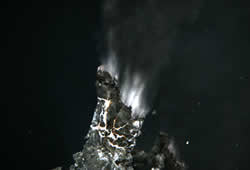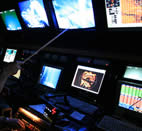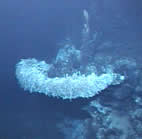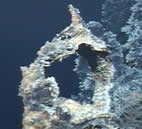
 |
| |
||||||||||||||||
|
||||||||||||||||||||||||||||||||||||||||||||||||||||||
 Close-up view of El Guapo 'fire' at the International District vent field in Axial's caldera. (click image for larger view) |
One of our goals for the NeMO project is to monitor changes in chemical composition over long time scales, and to see how hydrothermal systems respond to volcanic activity. We have been sampling vent sites around the Axial Volcano caldera at regular intervals since the 1998 eruption.
We have two approaches to time series sampling. One is to install monitoring instruments that automatically take water samples at programmed times, typically about once per week, and then recover the instruments after a year and re-deploy another instrument for the following year. The instruments we use for this are called Remote Access Samplers, or RAS. These instruments take quite a lot of care to maintain and set up between deployments. This year I had help before the cruise from my daughter Elise in getting one of the instruments ready to go in the water. I had a lot more help at sea from the chemistry team: Kevin Roe, Noah Lawrence, Annie Bourbonnais, and Eric Olson. It is a major event when one of these instruments arrives at the surface. We quickly wash the instrument off, remove the 48 sample bags and put them in the refrigerator, remove the 48 filters, and then start analyzing the samples. It takes about 15 to 20 minutes per sample just to do the basic processing (not including the chemical analysis), so it takes a couple days to get through them. The results tell us what happened at a particular vent over a year, and in some cases we have seen interesting effects from earthquake activity. We are still waiting for a significant volcanic event to occur while we have an instrument in place, and the only way to achieve that is to maintain a long-term monitoring program.
The other approach that we use to understand the chemistry of hydrothermal systems is an intensive sampling program conducted with a specialized instrument attached to the remotely operated vehicle. This instrument is officially called the hydrothermal fluid and particle sampler (HFPS), but it is almost always referred to by the nickname “the Beast”. We have a newly re-designed, slimmer, lighter, and easier to manage Beast this year. (Thanks to Noah for the design and project work.) The Beast can take a large number of water samples (18) in either collapsible bags or sturdy pistons, and can also take 6 filters to collect microbial DNA from vent fluids. The Beast is not difficult to set up, but it does take a lot of care to collect samples and handle them properly when they reach the laboratory. One of the interesting properties of hot springs at Axial Volcano is that they have extremely high gas content derived from the magma chamber beneath the volcano. Due to a slight plumbing error, we ended up with too much of an extremely gassy water sample from a new vent in one of our piston samplers. The sampler contained the gassy sample very well, but the only way to get it out was to open a port. When we did so, water and gas exploded out of the port, covering me with gassy water like some malignant bottle of celebratory champagne. I managed to catch about 2/3 of the water in a bottle, and no harm done. The plumbing mistake was corrected, and we managed to handle later gassy samples without losing any water or gas.
This was a hugely successful year for sampling with the Beast, covering every known vent area around Axial Caldera, and sampling some vents for the first time. The whole team has been busy non-stop for the whole cruise, and we are now packing up all the samples and gear to take back to the lab. We’re ready for a breather, and then we’ll get into the detailed analysis of the samples to see what has changed over this past year.
.
|
Sep/Oct 2004
| ||||||
| S | M | T | W | T | F | S |
| 12 | 13 | 14 | 15 | 16 | 17 | 18 |
| 19 | 20 | 21 | 23 | 24 | 25 | |
| 26 | 27 | 28 | 29 | 30 | 1 | 2 |
Today's Events:
.Jason dive J2-294 ends.
CTD and dive J2-295 at Split Volcano.
|
Today's
photos |
|
click
caption for larger view |
 Dave directing the location of a fluid sample in Jason's camera display. |
 Harry Vent at Cobb. |
 Hermione Vent at Cobb. |
| NeMO Home |About NeMO | Expeditions | NeMO Net | Explore | Dive! | Education |